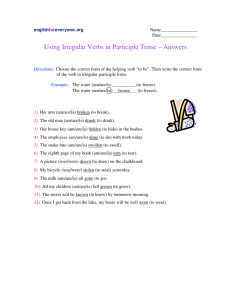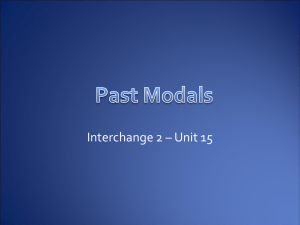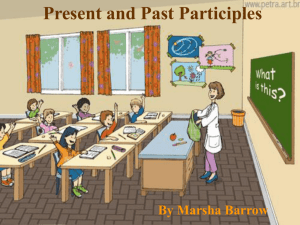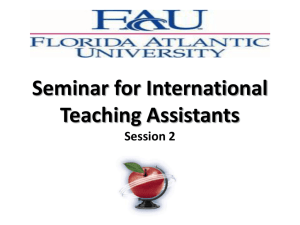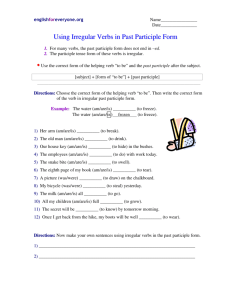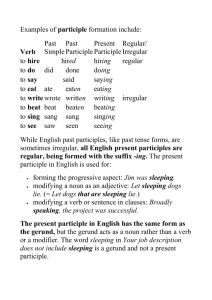Participle I of German Language and its Corresponding Forms in... Brunilda Vërçani MA Journal of Educational and Social Research MCSER Publishing, Rome-Italy
advertisement
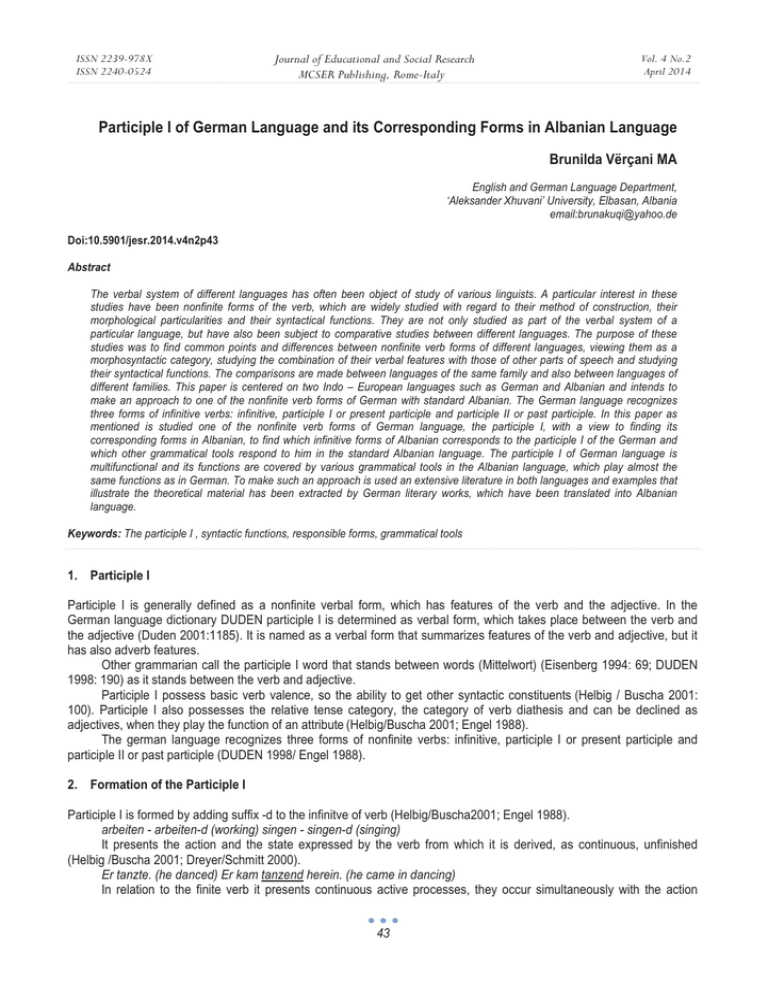
ISSN 2239-978X ISSN 2240-0524 Journal of Educational and Social Research MCSER Publishing, Rome-Italy Vol. 4 No.2 April 2014 Participle I of German Language and its Corresponding Forms in Albanian Language Brunilda Vërçani MA English and German Language Department, ‘Aleksander Xhuvani’ University, Elbasan, Albania email:brunakuqi@yahoo.de Doi:10.5901/jesr.2014.v4n2p43 Abstract The verbal system of different languages has often been object of study of various linguists. A particular interest in these studies have been nonfinite forms of the verb, which are widely studied with regard to their method of construction, their morphological particularities and their syntactical functions. They are not only studied as part of the verbal system of a particular language, but have also been subject to comparative studies between different languages. The purpose of these studies was to find common points and differences between nonfinite verb forms of different languages, viewing them as a morphosyntactic category, studying the combination of their verbal features with those of other parts of speech and studying their syntactical functions. The comparisons are made between languages of the same family and also between languages of different families. This paper is centered on two Indo – European languages such as German and Albanian and intends to make an approach to one of the nonfinite verb forms of German with standard Albanian. The German language recognizes three forms of infinitive verbs: infinitive, participle I or present participle and participle II or past participle. In this paper as mentioned is studied one of the nonfinite verb forms of German language, the participle I, with a view to finding its corresponding forms in Albanian, to find which infinitive forms of Albanian corresponds to the participle I of the German and which other grammatical tools respond to him in the standard Albanian language. The participle I of German language is multifunctional and its functions are covered by various grammatical tools in the Albanian language, which play almost the same functions as in German. To make such an approach is used an extensive literature in both languages and examples that illustrate the theoretical material has been extracted by German literary works, which have been translated into Albanian language. Keywords: The participle I , syntactic functions, responsible forms, grammatical tools 1. Participle I Participle I is generally defined as a nonfinite verbal form, which has features of the verb and the adjective. In the German language dictionary DUDEN participle I is determined as verbal form, which takes place between the verb and the adjective (Duden 2001:1185). It is named as a verbal form that summarizes features of the verb and adjective, but it has also adverb features. Other grammarian call the participle I word that stands between words (Mittelwort) (Eisenberg 1994: 69; DUDEN 1998: 190) as it stands between the verb and adjective. Participle I possess basic verb valence, so the ability to get other syntactic constituents (Helbig / Buscha 2001: 100). Participle I also possesses the relative tense category, the category of verb diathesis and can be declined as adjectives, when they play the function of an attribute (Helbig/Buscha 2001; Engel 1988). The german language recognizes three forms of nonfinite verbs: infinitive, participle I or present participle and participle II or past participle (DUDEN 1998/ Engel 1988). 2. Formation of the Participle I Participle I is formed by adding suffix -d to the infinitve of verb (Helbig/Buscha2001; Engel 1988). arbeiten - arbeiten-d (working) singen - singen-d (singing) It presents the action and the state expressed by the verb from which it is derived, as continuous, unfinished (Helbig /Buscha 2001; Dreyer/Schmitt 2000). Er tanzte. (he danced) Er kam tanzend herein. (he came in dancing) In relation to the finite verb it presents continuous active processes, they occur simultaneously with the action 43 ISSN 2239-978X ISSN 2240-0524 Journal of Educational and Social Research MCSER Publishing, Rome-Italy Vol. 4 No.2 April 2014 expressed by the conjugated verb. Although it is called present participle it does not express the present, but simultaneity with the conjugated verb. It expresses a neutral tense and habitually it refers to the tense expressed by the finite main verb. In its predicative use it presents anteriority or posteriority in relation with the finite verb (Engel 1988: 431). Er sagte erläuternd… (Ai thoshte duke shpjeguar… / he said explanatory…) Er sagt erläuternd… (Ai thotë duke shpjeguar…/ he says explanatory…) Er hat erläuternd gesagt… (Ai ka thënë duke shpjeguar… / he has/had explanatory said…) Participle I is connected with nouns or verbs, connection which can be further expanded with other parts of the sentence or syntactic constituents. These expanded participle form constructions, which in the german language are called participle constructions (Helbig/Buscha 2001, Rath 1971). … einen über die Knie reichenden Gurtkittel… (… një përparëse me rrip, që i arrinte mbi gjunjë… / one over the knee reaching coat) … wo … Herr Albin mit hängenden Mundwinkeln und weltmännisch wegwerfenden Bewegungen die Karten handhabte. (… ku zoti Albin i zotëronte letrat me cepat e buzëve varur dhe me lëvizje mondane, që duken sikur hedhin tutje. / where Mr. Albin with drooping corners of the mouth and urbane dismissive movements handled the cards.) 3. The Syntactic Functions of the Participle I The grammarian distinguish three syntactic functions of participle I: predicative function, adverbial function and attributive function (Helbig/Buscha 2001:583). Predicative function In the predicative function refers participle I or the participle construction to the finite verb. They can have a free word order. By predicative constructions are expressed two actions, the one is expressed by the finite verb and the other by predicative. Predicative constructions can be paraphrased by subordinate clauses or coordinate clauses with the coordinating conjunction und (dhe / and) (Helbig/Buscha 2001:585). Settembrini war teilnehmend (Setembrini ishte pjesëmarrës/ po merrte pjesë/ Setembrini was participating) … so Auge in Auge, die seinen seien … flackernd… (kështu sy më sy, të sajët ishin vezullues /… eye to eye, her eyes were twinkling) … sagte er tief aufseufzend. ( Tha duke psherëtirë thellë / dhe psherëtinte thellë. / he said, suspiring deeply) … und trat dann sanft blickend zu seinem Vater. ( … hyri duke vështruar të atin butësisht./ … and then went looking softly for his father) To the particle I as predicative corresponds in the Albanian language the nonfinite form of gerund ( blickte ihn lachend… / e shihte duke qeshur) . It has the same function as the participle I of german language and can be paraphrased by coordinate clauses with the coordinating conjunction dhe (and) (und trat dann sanft blickend zu seinem Vater. ( … hyri duke vështruar të atin butësisht / dhe shihte të atin) The adverbial function The adverbial constructions as well as the predicative constructions refer to the finite verb of the sentence. Between the participle I or the construction with the participle I and the verb which it refers to, needs to have accordance of the semantic features. If this accordance lacks then lose these constructions their adverbial character. The adverbial constructions have a free word order. They may change their position without transforming the meaning of the sentence. … blickte ihm lachend und kopfschüttelnd ins Gesicht. (… e shihte në fytyrë duke qeshur dhe duke tundur kokën. / looked him in the face, laughing and noding his head.) …blickte ihm und lachte… / und danach lachte…. (… e shihte dhe qeshte / looked at him and laughed) Lachend und kopfschüttelnd blickte er ihm ins Gesicht… ( Duke qeshur e duke tundur kokën e shihte në fytyrë…/ looked him in the face, laughing and noding his head…) By the adverbial constructions there is an action expressed by the finite verb, an action which is further characterized by the mood, tense, cause etc. of the action expressed by the verb. The adverbial constructions can be paraphrased by a subordinate sentence which conjunction indicates corresponding semantic relations between main sentence and subordinate sentence. These relations are: modal, temporal, causal, conditional, concessive (Helbig / Buscha 2001; Dreyer/Schmitt 2000). …nahm …. kurz aufsitzend wieder Platz. ( Zuri sërish vend duke ndenjur drejt… / took place … junge Leute… kamen trällernd herein. ( … të rinjtë hynë duke kënduar me zë të lartë / young people ... came humming in) 44 ISSN 2239-978X ISSN 2240-0524 Journal of Educational and Social Research MCSER Publishing, Rome-Italy Vol. 4 No.2 April 2014 … klang … jammernd (… tingëllonte si ankuese / si ankim / si ankesë…. / sounded yammering) Neben ihnen fiel ein Wasser … gurgelnd und plätschernd zu Tal. (Pranë tyre rridhte ujë … duke gurgulluar dhe duke u përplasur / Next to them flowed water gurgling and splashing down into the valley) … sagte Joachim erläuternd… (… tha Joachim duke shpjeguar… / …Joachim said explanatory…) Wiedemann, speichelnd und blutend, zeigte das Phänomen… (Wiedeman duke pështyrë e duke nxjerrë gjak tregonte fenomenin / tek pështynte e nxirrte gjak / wiedemann spitting and bleeding told the phenomenon). Und der Hofrat klopfte abwechselnd links oben an der Brust und etwas weiter unten. (dhe këshilltari trokiste gishtat here majtas lart në kraharor dhe herë disi më poshtë / the councilor knocked the fingers alternating left at the breast and a little further down). To the participle I as adverb corresponds in the Albanian language the nonfinite form of gerund (erläuternd – duke shpjeguar) , which has almost the same functions as the participle I of the german language. Also corresponds to him a substantive with preposition or substantives without prepositions (jammernd – duke u ankuar / ankim / ankesë). There are also cases in which the context of the sentence, by leaving out the participle I, elucidates its meaning. (Und der Hofrat klopfte abwechselnd links oben an der Brust und etwas weiter unten. / dhe këshilltari trokiste gishtat here majtas lart në kraharor dhe herë disi më poshtë). Atrributive function Participle I or participle constructions refer to a noun and are placed between the noun and its article. They have an obligatory or fixed word order and do not change their position, because a different order of the parts of the sentence would change or break the meaning of the sentence. Participle I or participle construction as an attribute can be substituted by a relative sentence maintaining the sentence meaning. (Helbig/Buscha 2001, Rath 1971; Franco Vazquez 1985; Mallo Dorado 2006; Dreyer/Schmitt 2000). Between the participle or the participle construction and the noun , which it refers to exist an accordance of semantic features. If this accordance lacks then lose the constructions their attributive character. Ein … gaumig sprechendes Mädchen… ( Një vajzë, që fliste me grykë… / A ... girl speaking with cleft palate… or a girl, who speaks with cleft palate) … ging mit einer wegwerfenden Handbewegung hin. ( … iku me një lëvizje dore sikur hidhte dicka tutje. / went with a wave of the hand ) Die beleidigenden Worte (fjalë fyese / insulting words) Das nahestehende Fräulein (zonjusha, që rrinte pranë / the miss next to me) Eine schwebende Achtsamkeit ( vëmendje e lëkundur / që lëkundej / unstable attention) If participle I as attribute is a participle or an adjective this is a question that creates debate between various linguists. Some linguists are the opinion that exits real and unreal participles. (Mariller 1994; Eisengberg 1994; DUDEN 1998). To find similarities and differences between participles and adjectives needs to analyse semantic, lexical und syntactical attributes of both groups, but this was not part of this paper. In this paper participles as attribute are considered participles not adjectivs as they are considered by many other linguists. In the Albanian language corresponds to the participle I as an attribute a relative clause ( ein sprechendes Mädchen – një vajzë, që flet) , or another subordinate sentence (… ging mit einer wegwerfenden Handbewegung hin. / … iku me një lëvizje dore sikur hidhte dicka tutje). This role can be played also by a verbal adjective (die beleidigenden Worte / fjalë fyese; eine schwebende Achtsamkeit / vëmendje e lëkundur) that is another corresponding form of participle I. As well by the participle as adverb there are also cases in which the context of the sentence, by leaving out the participle I, elucidates its meaning. 4. Conclusions To the participle I in the adverbial and predicative function corresponds in the Albanian language the finite verbal form of gerund, while in its function as attribute correspond to him various grammatical tools. One of them is the relative clause also the verbal adjective, in other cases can be a noun accompanied or not by a preposition the corresponding form o the participle I in the Albanian. There are also cases in which the participle I lacks in the sentence and it is presumed. 45 ISSN 2239-978X ISSN 2240-0524 Journal of Educational and Social Research MCSER Publishing, Rome-Italy Vol. 4 No.2 April 2014 References Akademia e Shkencave (1995) : „Gramatika e gjuhës shqipe“, Tiranë 1995 Bungarten Th. (1976) : Präsentische Partizipialkonstruktionen in der deutschen Gegenwartssprache Düsseldorf Çeliku M. (2000): „Format e pashtjelluara të foljes në gjuhën e sotme shqipe“, Tiranë Çeliku M.(1998) : „Gramatika praktike e gjuhës shqipe“, Tiranë Çeliku M.(2012) : „Sintaksë e gjuhës shqipe“, Tiranë Dreyer / Schmidt (2000): Lehr- und Übungsbuch der deutschen Grammatik, Ismaning Duden (2001): „Deutsches Universalwörterbuch“, Mannheim , 1185 Duden (2005): „Die Grammatik“, Mannheim 190-194 Eisenberg P. (1989) : “Grundriss der deutschen Grammatik”, Stuttgart Eisenberg P. (1994): Die Syntax des Mittelwortes. Läßt sich die Kategorisierung der Partizipien einzelsprachlich rechtfertigen? In: Bresson, D. / Dalmas, M. (Hrsg.): Partizip und Partizipialgruppen im Deutschen. Tübingen. 69 - 89 Engel U. (2004): “Deutsche Grammatik” München 430 - 432 Franco Vazquez S.-L. Das deutsche Partizip I als nominales Determinans und seine Ubersetzung ins Spanische. Dissertation, Tübingen. Helbig, G. / Buscha, J. (1996 ; 2001): Deutsche Grammatik. Ein Handbuch für den Ausländerunterricht. Leipzig. 99 – 100 ; 107 – 108 ; 494 – 495; 583-590 Hentschel/Weydt (1994) : „Handbuch der deutschen Grammatik“, Berlin Mallo Dorado, A.(2008): Das deutsche Partizip in der Verwaltungs- und Behördensprache und seine spanische Äquivalenzen Doctoral Dissertation Mallo Dorado A. (2006) : Äquivalenz der deutschen Partizipien im Spanischen. In: Deutsche Grammatik im europäischen Dialog. Krakow (online) Mallo Dorado A. (2006) : Die deutschen Partizipien und ihre spanischen Entsprechungen. In: Linguistik im Schloss II . Czernowitz 87 103 (online) Mann T.: Der Zauberberg, Berlin 1924/16.Auflage 2004 Marillier, J.-F. (1994): Was sind Partizipien? In: Bresson, D. / Dalmas, M. (Hrsg.): Partizip und Partizipialgruppen im Deutschen. Tübingen. 19-32. Rath R.(1971) „Die Partizipialgruppe in der deutschen Gegenwartssprache“, Düsseldorf Sommerfeldt / Starke (1998) : „Einführung in die Grammatik der Gegenwartsprache“, Tübingen Valentin Paul (1994): “Über Nicht-Partizipien und Partizipien im heutigen Deutsch”, në Bresson, Daniel / Dalmas, Martine (Hrsg.): Partizip und Partizipialgruppen im Deutschen.Tübingen 33-45 Zifonun, G. et al. (1997): Grammatik der deutschen Sprache. 3 Bde. Berlin/New York. 46
